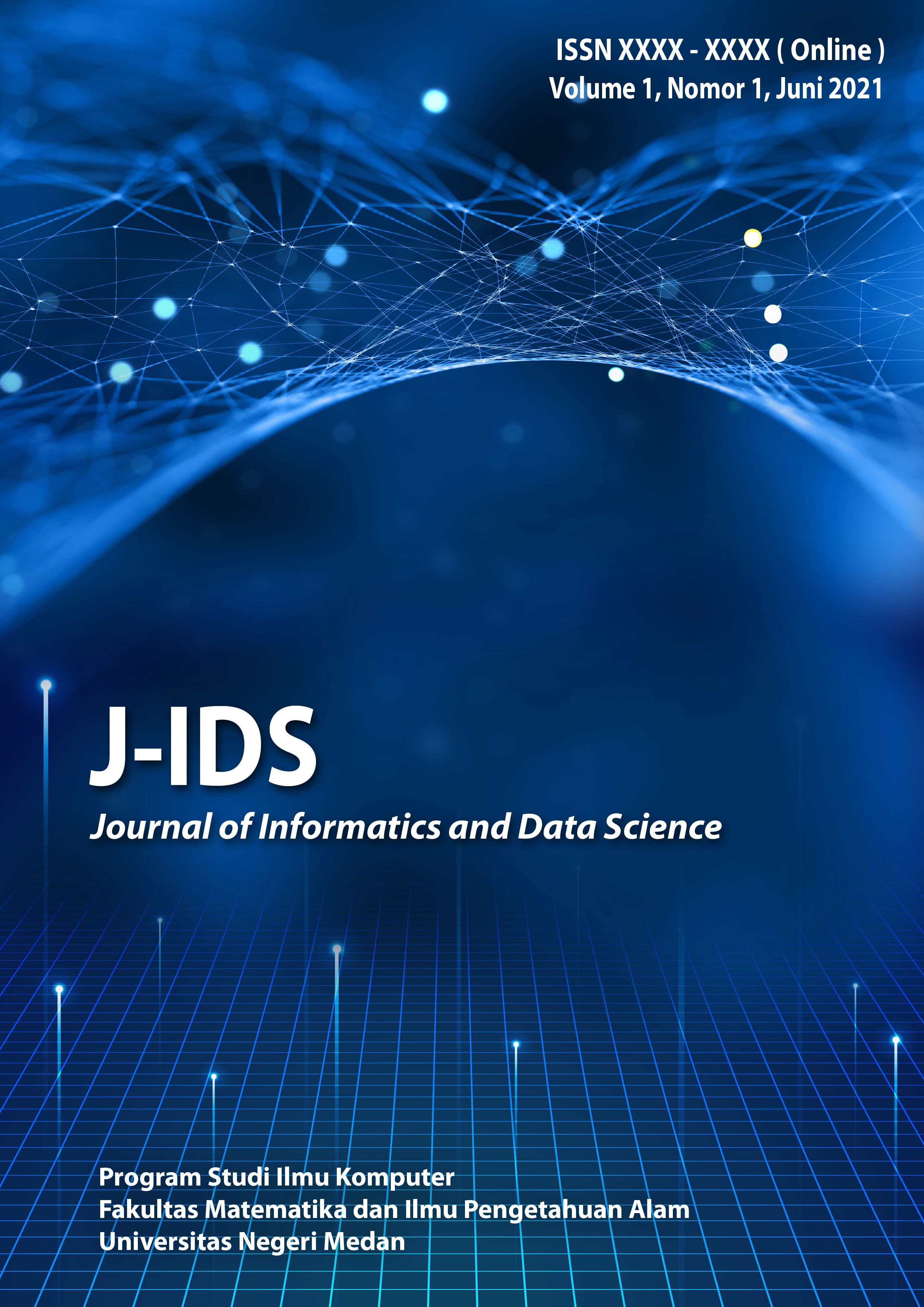Performance Comparison of VGG16, VGG19 and Alexnet Pre-Trained Transfer Learning Architecture Models in the Convolutional Neural Network Algorithm in Classification of Lung Disease
DOI:
https://doi.org/10.24114/j-ids.v3i1.51163Abstract
This study aims to comprehend the performance of transfer learning architectures (VGG16, VGG19, and Alexnet) in a Convolutional Neural Network for classifying lung diseases. Another objective is to determine the most superior transfer learning approach in this classification scenario. The dataset consists of 5 classes: normal lungs, pneumonia, bronchopneumonia, tuberculosis, and bronchitis. The data was sourced from Sinar Husni Deli Serdang Hospital through the radiology laboratory. The dataset was divided 80:20 for training and testing, with hyperparameters including a batch size of 32, 50 epochs, and optimization using Adaptive Momentum Optimization with a learning rate of 0.001. The research findings reveal that the VGG19 transfer learning architecture achieves the best performance with an accuracy of 59.17%, precision of 62%, recall of 59.2%, and an f-1 score of 58.8%. VGG16 ranks second with an accuracy of 55.83%, precision of 58%, recall of 55.8%, and an f-1 score of 55.2%. Alexnet has an accuracy of 49.17%, precision of 53.2%, recall of 49.2%, and an f-1 score of 50.6%. In an external test with 50 data points, VGG16 attains an accuracy of 54%, VGG19 scores 42%, and Alexnet records 46%. These models perform better in classifying normal lungs and tuberculosis compared to pneumonia, bronchopneumonia, and bronchitis. Analysis of lung image data demonstrates that homogeneity of RGB pixel values within a class supports transfer learning performance in classification. Conversely, heterogeneity in RGB pixel values can diminish the evaluation of that class.References
S. Chen, Z. Sedghi, F. Dubost, G. Van Tulder, and M. De, œAn end-to-end approach to segmentation in medical images with CNN and posterior-CRF, Med. Image Anal., vol. 76, p. 102311, 2022, doi: 10.1016/j.media.2021.102311.
P. M. M. Pereira et al., œMelanoma classification using light-Fields with morlet scattering transform and CNN : Surface depth as a valuable tool to increase detection rate, Med. Image Anal., vol. 75, p. 102254, 2022, doi: 10.1016/j.media.2021.102254.
B. D. Prasetyo, œLEMBAR PENGESAHAN KLASIFIKASI CITRA X-RAY PARU-PARU ANAK PNEUMONIA DAN NON-PNEUMONIA MENGGUNAKAN METODE SEGMENTASI DAN DETEKSI TEPI TUGAS AKHIR Diajukan sebagai Salah Satu Syarat untuk Memperoleh Gelar Sarjana Teknik pada Program Studi Teknik Elektro Faku, 2020.
I. Buana and D. A. Harahap, œAsbestos, Radon Dan Polusi Udara Sebagai Faktor Resiko Kanker Paru Pada Perempuan Bukan Perokok, AVERROUS J. Kedokt. dan Kesehat. Malikussaleh, vol. 8, no. 1, p. 1, 2022, doi: 10.29103/averrous.v8i1.7088.
R. Moch Diar, R. Y. Fu™adah, and K. Usman, œKlasifikasi Penyakit Paru-Paru Berbasis Pengolahan Citra X Ray Menggunakan Convolutional Neural Network (Classification Of The Lung Diseases Based On X Ray Image Processing Using Convolutional Neural Network), e-Proceeding Eng., vol. 9, no. 2, pp. 476“484, 2022.
L. A. Andika, H. Pratiwi, and S. S. Handajani, œKlasifikasi Penyakit Pneumonia Menggunakan Metode Convolutional Neural Network Dengan Optimasi Adaptive Momentum, Indones. J. Stat. Its Appl., vol. 3, no. 3, pp. 331“340, 2019, doi: 10.29244/ijsa.v3i3.560.
N. P. Ekananda and D. Riminarsih, œIdentifikasi Penyakit Pneumonia Berdasarkan Citra Chest X-Ray Menggunakan Convolutional Neural Network, J. Ilm. Inform. Komput., vol. 27, no. 1, pp. 79“94, 2022, doi: 10.35760/ik.2022.v27i1.6487.
T. Y. Liu, H. Q. Zhang, H. X. Long, J. Shi, and Y. H. Yao, œConvolution neural network with batch normalization and inception-residual modules for Android malware classification, Sci. Rep., vol. 12, no. 1, pp. 1“17, 2022, doi: 10.1038/s41598-022-18402-6.
B. Baba, U. Al, A. Mandar, U. Hasanuddin, I. S. Areni, and U. Hasanuddin, œGabor Filter Evaluation for Binary Threshold Image Processing in Early Detection Application, no. May 2020, 2018.
S. Bhahri and Rachmat, œTransformasi Citra Biner Menggunakan, J. Sist. Inf. dan Teknol. Inf., vol. 7, no. 2, pp. 195“203, 2018.
F. D. Adhinata, N. Annisa, F. Tanjung, W. Widayat, and G. R. Pasfica, œComparative Study of VGG16 and MobileNetV2 for Masked Face Recognition, vol. 7, no. 2, pp. 230“237, 2021, doi: 10.26555/jiteki.v7i2.20758.
S. Sennan, D. Pandey, Y. Alotaibi, and S. Alghamdi, œA Novel Convolutional Neural Networks Based Spinach Classification and Recognition System, Comput. Mater. Contin., vol. 73, no. 1, pp. 343“361, 2022, doi: 10.32604/cmc.2022.028334.
A. Julianto, A. Sunyoto, D. Ferry, and W. Wibowo, œOptimasi Hyperparameter Convolutional Neural Network Untuk Klasifikasi Penyakit Tanaman Padi (Optimization of Convolutional Neural Network Hyperparameters for Classification of Rice Plant Diseases), [Online]. Available: https://www.kaggle.com/tedisetiady/leaf-rice-dis-
R. Poojary, R. Raina, and A. K. Mondal, œEffect of data-augmentation on fine-tuned CNN model performance, vol. 10, no. 1, pp. 84“92, 2021, doi: 10.11591/ijai.v10.i1.pp84-92.
H. M and S. M.N, œA Review on Evaluation Metrics for Data Classification Evaluations, Int. J. Data Min. Knowl. Manag. Process, vol. 5, no. 2, pp. 01“11, 2015, doi: 10.5121/ijdkp.2015.5201.











